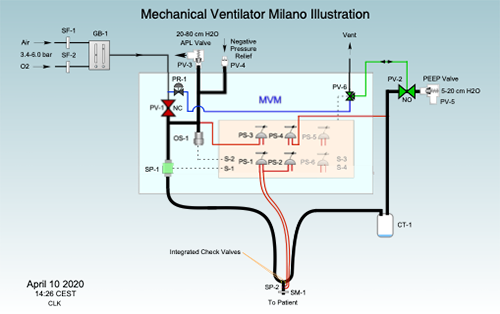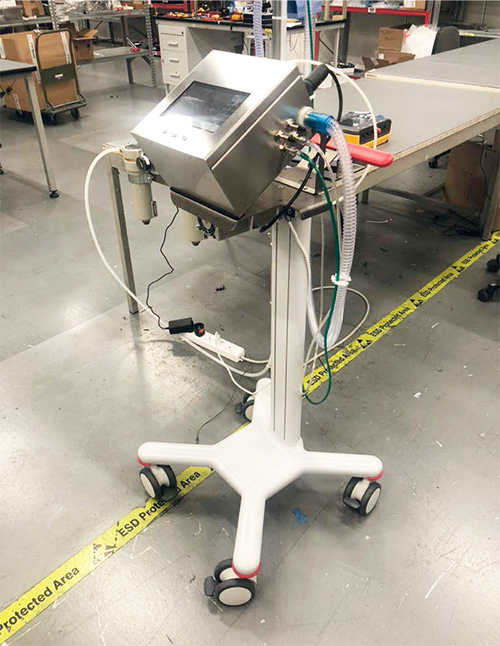Mechanical ventilator Milano (MvM)
The rapid and widespread of the Covid-19 has created an urgent demand for ventilators on a global basis, exceeding current national production capacities and supply from other countries, especially in some areas where imports are problematic.
This need has motivated a team of researchers, scientists and companies to develop a project for a mechanical ventilator called MvM (Mechanical ventilator Milano) [1], a reliable and easy to use device, that can be produced quickly and on a large scale, using components available on the market. The idea behind the MvM project is inspired by the ventilator designed by Roger Manley in 1961, based on the possibility of using the gas pressure of an anesthetic machine as the motive power to ventilate the patients' lungs.

Eugenio Scapparone
MvM relies on the same principle of simplicity but does not use a volume measurement system supplied to the patient directly at each respiratory cycle. Instead, it uses a pressure-controlled mode; it is based on a system of electro-mechanical valve and pressure, and oxygen sensors connected to an electrical control unit.
The heart of the device consists of a microcontroller that implements the logic for managing the respiratory process and dialogues with a chip with a processor. The Graphic User interface is provided by an LCD display that monitors the patient's parameters and makes system settings available for the medical personnel. Fig. 1 shows an illustration of the MvM ventilator and the breathing circuit.
The broad spectrum of knowledge required to build an electro-mechanical pulmonary ventilator ranges from medicine to electronics, from sensor technology to software development:
The collaboration between a large network of research organizations and active companies was mandatory for the initiative's success in areas relevant to the project. The MvM project was born on the idea and initiative of some researchers of the international collaboration Global Argon dark Matter (GAdM) engaged in research activities on dark matter, an invisible component of the universe, working at the National Laboratories of the Gran Sasso of iNFN and in Canadian laboratories of SNoLAB and TRiUMF.
More than 150 researchers from Italy, Canada, the USA and several European countries, are involved in this project; From Italy, a large team of physicists, engineers (mechanical, electrical, electronic) and physicians from INFN, CNR, GSSiI, eight universities (Unibg, Unibs, Unimi, Unimib, Unina, Unipv, Unica and Uninsubria) and six industries: Azpneumatica, Belpower, Camozzi, Elemaster, Nuclear instruments and Saturn Magnetic.
In the last weeks, a prototype of the MvM device (fig. 2) was developed at the Elemaster company, based on physicians' recommendations, particularly pulmonologists and anesthetists.
The FDA (Food and Drug Administration) authorization was issued in May, within the scope of the emergency use.
The project is currently in the advanced testing phase, required for CE certifications, carried out by researchers from Italy and other countries.
The MvM prototype uses a controlled pressure ventilation mechanism (PCv) and can be used in two different modes, independent or patient assisted. The system connects directly to a pressurized medical oxygen line and it is based on the regulation of the flow necessary to provide a mixture of air and oxygen to the patient at the appropriate pressure.

Fig 1: MvM ventilator and the breathing circuit

Fig 2: MvM device
The relevant features of MvM are:
a) Reduced number of components: MvM consists of electro-mechanical valves, a medical care flowmeter for direct regulation of the maximum flow rate, an oxygen therapy humidifier, pressure and oxygen sensors, manual valves and medical hoses. A VDC battery provides the backup power supply for the control system;
(b) Ease of supply: the parts required for the construction of MvM have been selected from those available in many nations.
The selected parts are also characterized by the ease of use in the production and assembly of the device on a large scale;
c) Constructive simplicity: the assembly of the parts in a complete MvM will be feasible based on a small set of clear instructions. The software is open-source and available for customization by end-users;
d) Cost containment: the preliminary estimate of the total cost of the components is encouraging compared to the market price of this kind of devices;
e) Easy installation: the device only requires connections to a pressurized oxygen line and power supply Standard AC (220 v or 110 v); this feature allows its use in clinics with centralized oxygen and air supply systems (Covid-19 hospitals or Covid-19 care areas in general hospitals), but also for home care and use in ambulances;
f ) Customization: thanks to the development of specific algorithms, the MvM can operate in different ventilation modes: independent and patient assisted. The operator's operating parameters can be adjusted through a simple user interface; besides, the software will be implemented to increase the versatility of the graphic interface and offer customizable settings to the individual patient, with the possibility of remote control of the device parameters.
g) Reliability: the MvM is designed to be easily repairable, replacing individual parts that may not work;
h) Limited oxygen consumption: oxygen consumption with this device will not exceed 6LPM.
The final result of the project will be the availability of a certified ventilator ready for mass production in a short time. The characteristics will also be defined on the basis of clinical experience with the available prototypes and to create a machine that can follow the care of the Covid-19 patient from the first to the last day of hospitalization.
The example of MvM underlines the strategic role of fundamental research and how it provided a concrete contribution to tackling this emergency in a very short time.
At crucial moments, thanks also to the researchers (many of whom are women), who study the physics of astroparticles and elementary particles, both the knowledge and the technological infrastructure of research institutions and universities have been made available to the country.
In addition to MvM, several initiatives have been developed in recent weeks to fight the Covid-19. At INFN, the CNAF has made computing and data-storage power available for studies dedicated to developing new drugs and understanding the mechanisms of the formation of proteins linked to the spread of infections. A working group is carrying out the statistical analysis of pandemic data on a daily basis.
At the same time, at LNS (National Laboratories of the South), in collaboration with the University of Catania, new laboratories have been set up to verify the functional qualities of tissues for the production of masks to prevent the infection.
In this dramatic context, the positive impact on the society of the investments in the research sector is once again evident; we hope that this crucial role will be taken into account by the governments in the post-Covid phase.
Eugenio Scapparone started his research activity at the end of the '80s, joining the MACRO experiment at INFN Laboratori Nazionali del Gran Sasso (LNGS), led by B. Barish. Later he moved to INFN-Bologna to join the construction of the ALICE Time of Flight detector. In 2008 he spent one year at CERN as Scientific Associate, to serve as ALICE Deputy Commissioning Coordinator and as member of the ALICE Technical Board. In the next years he was member of the ALICE Physics Board, convener of the ALICE "Forward Physics" Working Group (2012-2014) and of the "Minimum Bias" Physics Working Group (2016-2017).
In 2016 he joined the DarkSide Collaboration, serving as "Photo-electronics" L1 manager and later as Project Leader (2018-2019). In 2019 he was elected member of the Council of the European Physical Society Council. In 2020 he was appointed as Director of the INFN-Bologna, with 120 employees and about 200 associates.
Bibiliography
1] Mechanical Ventilator Milano (MVM): A Novel Mechanical Ventilator Designed for Mass Scale Production in Response to the COVID-19 Pandemic, C. Galbiati et al., arXiv:2003.10405
Disclaimer - The articles and opinion pieces found in this issue of the APS Forum on International Physics Newsletter are not peer refereed and represent solely the views of the authors and not necessarily the views of the APS.
